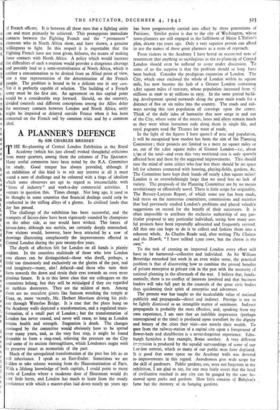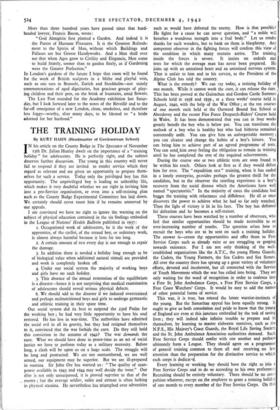A PLANNER'S DEFENCE
By SIR CHARLES BRESSEY The challenge of the exhibition has been successful, and the trumpets of laissez-faire have been vigorously sounded by champions on the other side, as one would have wished. The forces of laissez-faire, although not mobile, are certainly deeply entrenched. Few visitors would, however, have been attracted by a row of drawings illustrating complacently the improvements effected in Central London during the past twenty-five years.
The depth of affection felt for London on all hands is plainly evident. In the countless multitude of those who love London two classes can be distinguished—those who dwell, perhaps, a little too timorously and exclusively on the glories of the past, real and imaginary—many, alas! defaced—and those who turn their faces towards the dawn and strain their eyes towards an even more glorious future. It is to this latter class that my colleagues on the committee belong, but they will be misjudged if they are regarded as ruthless destroyers. They are the mildest of men. Among them are no truculent giants like Samson wrecking the temple at Gaza, or, more -ecently, Mr. Herbert Morrison driving his pick- axe through Waterloo Bridge. It is true that the plans hung on the Academy walls depicted a transformation, and a regulated trans- formation, of a small part of London ; but the transformation of London has never ceased, and never will cease, so long as London retains health and strength. Stagnation is death. The changes envisaged by the committee would obviously have to be spread over many years, and, as the very first step, it might be found desirable to form a ring-road, relieving the pressure on the City and some of its ancient thoroughfares, which Londoners might wish to preserve intact as memorials of the past.
Much of the unregulated transformation of the past has left us an evil inheritance. I speak as an East-Ender. Sometimes we are bidden to take solemn warning from the Haussmanisation of Paris. With a lifelong knowledge of both capitals, I could point to many parts of London where a moderate dose of Haussman would do '.cry little harm, and London has much to learn from the steady Persistence with which a master-plan laid down nearly 90 years ago has been progressively carried into effect by three generations of Parisians. Similar praise is due to the city of Washington, whose town-planners are still engaged in the fulfilment of Major L'Enfant's plan, drawn 150 years ago. Only a very superior person can afford to use the names of these great planners as a term of reproach.
From visitors to the Academy I have heard an occasional note of resentment that anything so sacrilegious as the re-planning of Central London should even be suffered to come under discussion. 'ro some of us the surprise is that the problem should so long have been burked. Consider the prodigious expansion of London. The City, which once enclosed the whole of London within its square mile, has now become the hub of a Greater London containing 1,821 square miles of territory, whose population increased from 71 millions in 1906 to 91 millions in 1935. In the same period build- ing development spread outwards along the great main roads for a distance of five or six miles into the country. The roads and rail- ways serving this vast population all converge upon the centre. Think of the daily tides of humanity that now surge in and out of the City, where some of the streets, lanes and alleys remain much as they were when horsemen rode along them in single file, and royal pageants used the Thames for want of roads..
In the light of the figures I have quotei of area and population, it will be recognised how modest has been the aim of the Planning Committee ; their projects are limited to a mere 20 square miles or so, out of the 1,821 square miles of Greater London—i.e., about 1/90 of the total—and even this very restricted area is only sparsely affected here and there by the suggested improvements. This should ease the mind of some critics who fear lest there should be no space left for schemes connected with housing, playing-fields, gardens, &c. The Committee have kept their hands off nearly 1,800 square miles! London is so overwhelmingly large that we need fear no lack of variety. The proposals of the Planning Committee are by no means revolutionary or offensively novel. There is little scope for originality. The Bressey-Lutyens Report, of which some use has been made, laid stress on the numerous committees, commissions and societies that had previously studied London's problems and placed valuab'e suggestions on record for the benefit of their successors. It is often impossible to attribute the exclusive authorship of any par- ticular proposal to any particular individual, seeing how many use- ful projects have been repeatedly advocated and frequently revived. All that one can hope to do is to collect and fashion them into a coherent whole. As Charles Reade said, after writing The Cloister and the Hearth, "I have milked r,000 cows, but the cheese is my own."
To the task of creating an improved London every effort will have to be harnessed—collective and individual. As Sir William Beveridge remarked last week in an even wider sense, the practical problem is that of discovering how to combine the proved benefits of private enterprise at private risk in the past with the necessity c.f national planning in the aftermath of the war. I believe that, funda- mentally, there is no conflict of interests involved and that business leaders will take full part in the counsels of the great civic bodies thus quickening their spirit of enterprise and adventure.
The present war has taught us the incalculable value of national publicity and propaganda—direct and indirect. Prestige is not to be lightly dismissed as an intangible matter of sentiment. Indirect propaganda is probably the most effective, and, speaking from my own experience, I am sure that an indelible impression (perhaps unrecognised at the time) is produced upon travellers by the dignity and beauty of the cities they visit—not merely -their wealth. To gaze from the railway-station of a capital city upon a foreground of flower-beds and shrubberies is a never-forgotten experience. Edin- burgh furnishes a fine example, Rome another. A very different impression is produced by the squalid surroundings of some of our Lor Jon termini, which so many of our public men have deplored. It is good that some space on the Academy walls was devoted to improvements in this regard. Aerodromes give wide scope for the skill of gardeners. Public gardens, too, were not forgotten in the exhibition, I am glad to say, for one may fairly assert that the level of civilisation reached in any city can be gauged by the care be- stowed upon parks and gardens. How little remains of Babylon's fame but the memory of its hanging gardens. More than three hundred years have passed since that hard- headed lawyer, Francis Bacon, wrote: "God Almightie first planted a Garden. And indeed it is the Purest of Humane Pleasures. It is the Greatest Refresh- ment to the Spirits of Man, without which Buildings and Pallaces are but Grosse Handyworks. And a Man shall ever see that when Ages grow to Civility and Elegancie, Men come to build Stately, sooner than to garden finely, as if Gardening were the Greater Perfection."
In London's gardens of the future I hope that room will be found for the work of British sculptors in a blithe and playful vein, such as one sees in Brussels, Zurich and Stockholm—not stately commemorations of aged dignitaries, but gracious groups of play- ing children and their pets, on the brink of fountains, amid flowers.
The Last Post sounded for the Academy exhibition last Satur- day, but I look forward later to the notes of the Reveille and to the far-off emergence of a new London, clean, smokeless, and therefore less foggy—worthy, after many days, to be likened to "a bride adorned for her husband."



























 Previous page
Previous page